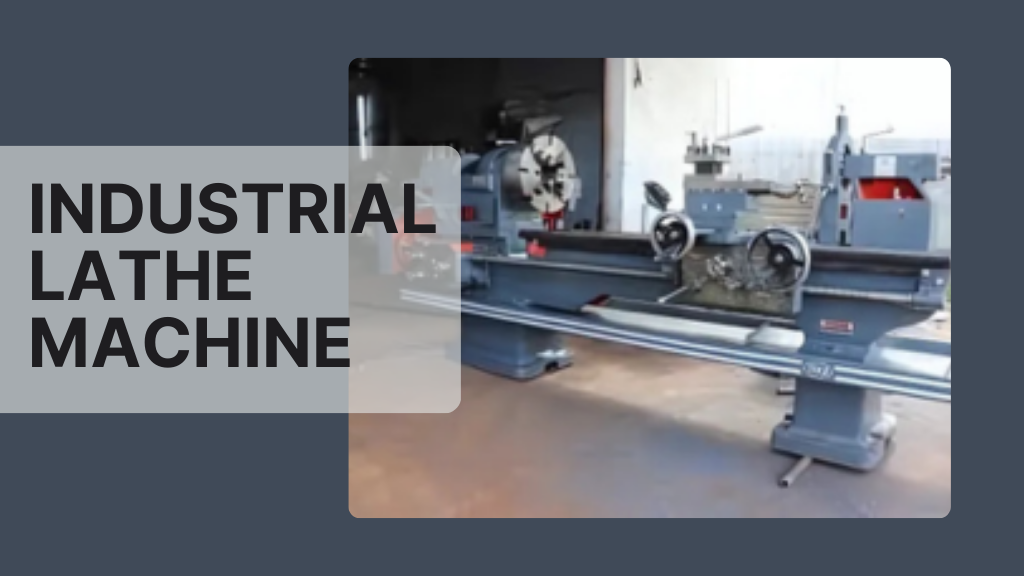The industrial lathe machine is one of the most important inventions in the history of manufacturing. Often called the mother of all machines, it is the foundation of modern engineering. From producing precise automotive parts to shaping components for aerospace and defense, the industrial lathe machine plays a central role in global industry.
Every manufacturer, factory, or workshop that requires shaping, cutting, or finishing materials relies on lathes for precision and efficiency. While smaller lathes exist for hobbyists or limited-scale use, industrial versions are designed to withstand continuous heavy-duty operations and handle high-volume production demands. This article explores the evolution, structure, functions, applications, benefits, and future of the industrial lathe machine in depth.
What is an Industrial Lathe Machine
An industrial lathe machine is a large-scale mechanical tool used to rotate a workpiece against a cutting tool. The cutting tool removes material to shape the workpiece into the desired dimensions and design. The process may involve turning, boring, drilling, facing, or threading.
Unlike traditional or small workshop lathes, industrial lathes are capable of handling large and heavy workpieces. They are also equipped with advanced features, particularly when automated with CNC technology, which enables greater accuracy and repeatability.
The Evolution of Industrial Lathe Machine
The history of lathe machines reflects the evolution of human technology.
Early civilizations, including the Egyptians, developed primitive bow lathes where a rope wrapped around the material rotated it back and forth while a tool shaped the surface. This method was slow but revolutionary for its time.
During the medieval era, the treadle lathe was introduced. Operated by foot pedals, it allowed continuous rotation of the workpiece. This invention increased productivity and laid the foundation for larger machines.
The Industrial Revolution in the 18th century transformed lathes with the use of steam and later electric power. These advancements allowed for stronger machines capable of working with metal, which was crucial for the booming industries of the time.
In the 20th century, motor-driven lathes became standard, and later, computer numerical control (CNC) lathes emerged. CNC technology brought automation, precision, and the ability to produce complex shapes with minimal manual input. Today, CNC industrial lathes dominate production floors worldwide.
Types of Industrial Lathe Machine
Industrial lathes are classified into several types based on their design and functionality.
-
Engine Lathe
The engine lathe is one of the most widely used machines in workshops and factories. It is versatile and capable of handling a variety of operations such as cutting, turning, and drilling. It is manually operated but has a mechanical feed system for efficiency.
-
Turret Lathe
Turret lathes are designed for repetitive operations, particularly in mass production. They are equipped with a turret that holds multiple cutting tools, which can be quickly rotated into position. This reduces downtime and improves efficiency in large-scale manufacturing.
-
CNC Lathe
The CNC lathe is the modern standard for industrial applications. Controlled by computer programs, it allows for highly precise machining. CNC lathes can produce complex parts with minimal error and can operate continuously, making them ideal for industries like aerospace, medical equipment, and automotive manufacturing.
-
Special-Purpose Lathes
Certain industries require highly specialized machines. Examples include vertical lathes for very large and heavy workpieces, wheel lathes for railway maintenance, and multi-spindle lathes for rapid production of identical components.
Components of an Industrial Lathe Machine
Understanding the main components of an industrial lathe is essential for safe operation, maintenance, and precision work. Each part plays a crucial role in ensuring smooth and accurate machining. Knowing these components helps operators optimize performance and avoid errors.
-
Bed
The bed is the heavy base of the lathe that supports all other parts. It provides stability and alignment during operations, ensuring precision. A well-built bed reduces vibrations and enhances the quality of machining.
-
Headstock
Located on the left side, the headstock contains the spindle and motor. It drives the rotation of the workpiece and powers various lathe operations. Proper maintenance of the headstock ensures smooth and reliable performance.
-
Tailstock
The tailstock is positioned opposite the headstock and supports the free end of the workpiece. It is especially useful for long or heavy materials. The tailstock can also hold tools like drills or reamers for additional operations.
-
Carriage
The carriage moves the cutting tool along the bed for machining tasks. It allows precise control over the tool’s position. The carriage ensures accurate turning, facing, and shaping of the workpiece.
-
Chuck
The chuck securely holds the workpiece during rotation. It comes in various designs, such as three-jaw or four-jaw chucks. A properly tightened chuck prevents slipping and maintains precision.
-
Tool Post
Mounted on the carriage, the tool post holds the cutting tool in place. It allows adjustment of tool position and angle for different operations. The tool post is essential for tasks like turning, facing, and threading.
-
Lead Screw
The lead screw is used for threading and precise movement of the carriage. It ensures consistent and accurate cutting along the workpiece. The lead screw is crucial for high-precision lathe operations.
Each component works together to provide stability, accuracy, and efficiency in industrial lathe machining. Proper understanding and maintenance improve both performance and safety.
Working Principle of Industrial Lathe Machine
The working principle is based on rotation and cutting. The workpiece is clamped into the chuck or between centers, after which it rotates at a chosen speed. The cutting tool is then pressed against the rotating workpiece to remove material. Depending on the depth of cut, feed rate, and tool shape, different operations can be performed such as turning, facing, or grooving.
In CNC lathes, the operator programs the sequence of operations, and the machine executes them with automated precision.
Applications of Industrial Lathe Machine
Industrial lathes are widely used across multiple industries due to their precision and versatility. They enable manufacturers to produce complex components efficiently and consistently. Understanding these applications highlights the importance of lathe machines in modern production.
1. Automotive Industry
In the automotive sector, lathes are used to manufacture crankshafts, camshafts, engine blocks, and gears. These components require high precision for optimal engine performance. Lathes ensure consistent quality and accurate dimensions.
2. Aerospace Industry
Aerospace manufacturing relies on lathes for turbine blades, landing gear components, and other structural parts. Precision is critical to meet strict safety and performance standards. Lathes provide the accuracy necessary for these high-stakes applications.
3. Medical Industry
Lathes are used to create surgical tools, dental instruments, and orthopedic implants. These applications demand extremely tight tolerances and smooth finishes. Industrial lathes help maintain quality and safety in medical devices.
4. Defense Sector
The defense industry uses lathes to shape parts for firearms, tanks, and aircraft. Components must meet exact specifications for reliability and durability. Lathes enable precise machining of metal and alloy materials for military applications.
5. Oil and Gas Industry
In the oil and gas sector, lathes fabricate pipeline parts, valves, and drilling components. These parts often endure high pressure and harsh conditions. Lathes ensure proper dimensions and performance under demanding environments.
6. General Metalworking
Industrial lathes are essential for general metalworking tasks, including repair work and custom fabrication. They allow machinists to produce both standard and specialized components. Lathes offer flexibility for small or large-scale production.
7. Woodworking
Lathes are also used in woodworking to mass-produce furniture components and decorative wooden artifacts. They allow precise shaping, smooth finishes, and consistent designs. This versatility makes lathes valuable beyond metalworking industries.
Advantages of Industrial Lathe Machine
Investing in industrial lathe machines offers significant benefits for manufacturers and machinists. They are essential tools for achieving precision, efficiency, and versatility in production environments. Understanding these advantages helps highlight why lathes remain a cornerstone of modern industry.
-
High Precision and Accuracy
Industrial lathes provide exceptional precision, ensuring components meet strict dimensional and tolerance requirements. This accuracy is critical in sectors like aerospace, automotive, and medical manufacturing. Precision reduces waste and improves overall product quality.
-
Ability to Work with Multiple Materials
Lathes can handle a wide range of materials including metals, plastics, and wood. This versatility allows manufacturers to switch between projects without investing in multiple machines. Working with different materials expands operational flexibility.
-
Increased Production Speed
Using lathes accelerates production by performing complex operations quickly and efficiently. Multiple tasks, such as cutting, shaping, and threading, can be done in one setup. This speed helps meet high-demand manufacturing schedules.
-
Automation Reduces Human Error
Modern industrial lathes often feature automated controls, minimizing mistakes caused by manual operation. Automation ensures consistent results across multiple components. Reduced human error leads to higher quality and lower rework costs.
-
Durability for Continuous Heavy Use
Industrial lathes are built to withstand heavy workloads and long operational hours. Their robust construction ensures longevity and reliability in demanding factory environments. Durability reduces maintenance costs and downtime.
-
Flexibility for Multiple Operations
A single lathe machine can perform various operations, including turning, drilling, threading, and facing. This flexibility eliminates the need for multiple machines, saving space and investment. It also allows quick adaptation to diverse production needs.
Factors to Consider When Buying an Industrial Lathe Machine
Selecting the right industrial lathe requires careful planning to ensure it meets production needs. The wrong choice can lead to inefficiencies, increased costs, and downtime. Evaluating all factors before purchase is essential for long-term success.
-
Determine the Type of Lathe
Identify the type of lathe that best suits your production requirements. Options include engine lathes, turret lathes, and CNC lathes. Each type has specific capabilities and applications, so choose one that aligns with your operations.
-
Evaluate Material Compatibility
Consider the materials you will be working with, such as metals, plastics, or wood. Ensure the lathe is designed to handle the hardness and thickness of your chosen materials. Material compatibility ensures smooth operation and reduces wear on the machine.
-
Consider Size and Work Capacity
Assess the lathe’s size, bed length, and swing capacity. The machine should accommodate the largest workpieces you plan to process. Proper sizing prevents operational limitations and maximizes efficiency.
-
Analyze Motor Power and Spindle Speed
Check the motor’s power output and spindle speed range to ensure the lathe can perform required operations. Higher power and variable speed options allow for more precise and efficient machining. This is crucial for both heavy-duty and delicate tasks.
-
Decide Between Manual or CNC Operation
Determine whether a manual or CNC-controlled lathe is best for your needs. CNC lathes offer automation, precision, and consistency, while manual lathes may be more cost-effective for simpler operations. Your choice depends on production volume and complexity.
-
Set a Realistic Budget
Establish a budget that covers the cost of the lathe, installation, and any required accessories. Factor in operational and maintenance expenses over time. A realistic budget ensures you invest in a machine that meets your needs without overspending.
-
Check After-Sales Support and Spare Parts
Verify that the manufacturer or supplier provides reliable after-sales support. Availability of spare parts and technical assistance is crucial for minimizing downtime. Strong support ensures your lathe operates efficiently throughout its lifespan.
Real-World Industry Example
A manufacturing company in the automotive sector implemented CNC industrial lathes to produce precision crankshafts. By upgrading from manual machines, they reduced cycle times by thirty percent, minimized material waste by twenty percent, and improved overall profit margins by fifteen percent. This illustrates the direct financial impact that advanced lathe machines can have on a production line.
Industrial Lathe Machine Market and Trends
The market for industrial lathes continues to expand.
- CNC machines dominate due to their automation capabilities.
- IoT integration is becoming common, enabling smart monitoring and predictive maintenance.
- Sustainability is a growing factor, with energy-efficient machines gaining preference.
- Asia-Pacific leads global demand, followed by North America and Europe.
The increasing need for precision and automation ensures steady growth for this industry.
Maintenance Tips for Long Life
Regular maintenance ensures performance and extends machine life.
- Lubricate all moving parts.
- Check spindle and tailstock alignment regularly.
- Keep the bed and carriage free from chips and dust.
- Replace worn-out tools promptly.
- Schedule preventive maintenance sessions.
Proper care can extend the lifespan of industrial lathes to more than two decades.
Safety Precautions
Operating heavy machinery requires strict safety measures.
- Always wear protective gear.
- Ensure proper clamping of workpieces.
- Never leave the machine running unattended.
- Follow manufacturer’s operational guidelines.
- Train operators regularly for safe handling.
The Future of Industrial Lathe Machine
The future lies in smart automation. Artificial intelligence and machine learning are being integrated into CNC lathes to enable predictive cutting and adaptive controls. Hybrid machines that combine milling and turning in a single setup are also gaining popularity. With advancements in material science, lathes are expected to handle advanced alloys and composites more efficiently.
Conclusion
The industrial lathe machine remains one of the most important machines in the manufacturing world. Its versatility, precision, and efficiency make it indispensable in industries ranging from automotive to aerospace. The evolution from manual to CNC lathes has made machining faster, more accurate, and more reliable than ever before.
Whether you are a factory owner, an engineer, or a workshop manager, understanding how to select, maintain, and operate an industrial lathe machine can directly influence productivity and profitability. By investing in the right equipment, following proper maintenance practices, and adapting to new technological trends, businesses can ensure long-term success in competitive markets.
Frequently Asked Questions
What is the difference between CNC and manual lathes
CNC lathes are computer-controlled, ensuring automation and higher precision, while manual lathes require operator skill and constant attention.
How long does an industrial lathe machine last
With regular maintenance, an industrial lathe can last between fifteen and twenty five years.
Can one industrial lathe machine handle multiple materials
Yes, with the right tooling, lathes can work with metals, wood, and even advanced plastics.
What industries rely most on lathe machine
Industries such as automotive, aerospace, defense, and oil and gas depend heavily on lathes.
Should small businesses buy new or used industrial lathe machine
Used machines can be cost effective if they are well maintained and inspected before purchase.




